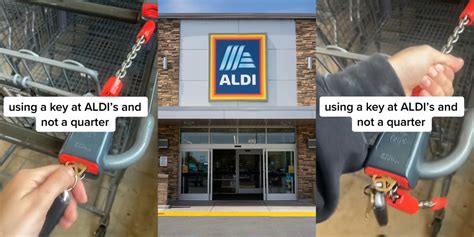
A viral TikTok hack promising to unlock Aldi shopping carts without a quarter is circulating online, demonstrating how a common household key or similar rounded object can bypass the coin-deposit mechanism, though Aldi has not officially commented on the trend’s effectiveness or potential impact.
Aldi shoppers are known for their resourcefulness, always on the lookout for ways to save time and money. The latest example of this ingenuity involves a viral TikTok hack that claims to unlock Aldi shopping carts without the need for a quarter. This hack, which has been making the rounds on social media, proposes that a standard house key or a similarly shaped object can be used to release the cart’s locking mechanism, potentially saving shoppers the hassle of carrying spare change or using a cart-retrieval key. While the hack has gained traction online, its reliability and potential implications remain a subject of discussion.
The premise behind the Aldi cart hack is simple: Aldi’s shopping carts require a quarter (or a cart-retrieval key specifically designed for this purpose) to unlock them. This system encourages customers to return the carts to their designated bays after use, reducing clutter in parking lots and minimizing the need for staff to collect abandoned carts. When a quarter is inserted, it releases the locking mechanism, allowing the customer to detach the cart. Upon returning the cart and re-locking it, the quarter is released back to the customer.
The TikTok hack suggests that instead of a quarter, a house key, particularly one with a rounded head, or any object of similar size and shape, can be inserted into the coin slot. The claim is that the key will depress the same mechanism as a quarter, thereby unlocking the cart. Numerous videos on TikTok show users demonstrating this technique, with varying degrees of success. Some users report that the hack works consistently, while others claim it is unreliable or only works with certain types of keys or carts.
Aldi, a German-based discount supermarket chain, operates over 2,000 stores in the United States. Its business model focuses on efficiency and cost-saving measures, which are reflected in its store layout, limited product selection, and the cart-rental system. By requiring a deposit for cart use, Aldi reduces operational costs associated with cart retrieval and maintenance, savings that the company says are passed on to customers through lower prices.
The potential impact of the hack is multifaceted. If the hack is widely adopted and proves reliable, it could undermine Aldi’s cart-rental system. This could lead to increased cart abandonment in parking lots, raising operational costs for the retailer. Alternatively, it could simply become a convenient workaround for customers who occasionally forget to bring a quarter.
However, the practicality of the hack remains questionable. Not all keys are created equal, and the size and shape of the key’s head can affect its ability to activate the locking mechanism. Furthermore, the design of Aldi’s carts may vary by location or manufacturing batch, potentially rendering the hack ineffective on certain carts. Some users have also noted that repeatedly using a key to unlock carts could potentially damage the locking mechanism over time, leading to maintenance issues for Aldi.
Despite the buzz surrounding the hack, Aldi has not officially commented on the matter. It remains unclear whether the company will take any action to address the potential circumvention of its cart-rental system. Possible responses could include modifying the cart design to prevent the use of keys or other objects, or issuing a statement advising customers against tampering with the carts.
The emergence of this hack underscores the ongoing tension between customer convenience and retailer efficiency. While Aldi’s cart-rental system is designed to benefit both the company and its customers, some shoppers are always seeking ways to streamline their shopping experience. Whether the key hack becomes a widely accepted practice or fades away as a fleeting trend remains to be seen. However, it highlights the power of social media in disseminating information and influencing consumer behavior.
The Aldi cart hack is not the first instance of customers attempting to find loopholes in retail systems. From self-checkout tricks to coupon stacking strategies, shoppers are constantly exploring ways to maximize savings and convenience. Retailers, in turn, are continually adapting their policies and technologies to maintain profitability and operational efficiency. This dynamic creates an ongoing cycle of innovation and adaptation in the retail landscape.
Many social media users have weighed in on the ethics of using the hack. Some argue that it is a harmless way to avoid the inconvenience of carrying a quarter, while others contend that it undermines Aldi’s system and could lead to increased costs for the retailer, which could ultimately be passed on to customers. The debate reflects broader discussions about consumer responsibility and the impact of individual actions on businesses.
It’s important to acknowledge the risks associated with using unauthorized methods to unlock shopping carts. While the key hack may seem innocuous, it could potentially damage the cart’s locking mechanism. Additionally, continually manipulating the locking system could be seen as a form of vandalism, which could have legal ramifications.
The Aldi cart hack serves as a reminder of the creative ways in which people adapt to everyday challenges. It also highlights the role of social media in amplifying these solutions and sparking wider conversations about consumer behavior and retail practices. As the trend continues to circulate, it will be interesting to observe its long-term impact on Aldi and its customers. For now, shoppers may want to weigh the potential benefits of the hack against the possible risks and ethical considerations before attempting to unlock a cart with a key.
To fully understand the context of this hack, it’s useful to delve into the history of shopping cart design and the evolution of retail security measures. The first shopping cart was invented in 1937 by Sylvan Goldman, the owner of a Humpty Dumpty supermarket chain in Oklahoma City. Goldman sought to create a device that would allow customers to purchase more items without having to carry heavy baskets. His initial design, which resembled two shopping baskets on a wheeled frame, was met with skepticism by both men and women. Men associated the cart with baby strollers, while women found it reminiscent of pushing a cumbersome object. However, after hiring models to demonstrate the carts in his stores, Goldman successfully overcame the initial resistance, and the shopping cart quickly became a ubiquitous feature of supermarkets worldwide.
Over the years, shopping cart design has undergone numerous refinements, with innovations such as improved wheel systems, ergonomic handles, and child seats. Retailers have also implemented various security measures to prevent cart theft and misuse. These measures range from simple wheel-locking mechanisms to sophisticated GPS tracking systems. The Aldi cart-rental system, which requires a deposit to unlock the cart, is another example of a security measure designed to encourage responsible cart usage and prevent theft.
The history of retail security is closely intertwined with the evolution of shopping carts. As carts became more prevalent, retailers faced the challenge of preventing theft and managing cart inventory. In the early days of supermarkets, cart theft was a relatively minor problem, as most customers lived within walking distance of the store. However, as suburbanization increased and car ownership became more common, cart theft became a more significant concern.
Retailers initially responded to this challenge by implementing simple measures such as posting signs warning against cart theft and employing staff to patrol parking lots. However, these measures proved to be inadequate in preventing cart theft on a large scale. In the 1960s, retailers began experimenting with more sophisticated security systems, such as wheel-locking mechanisms that would activate when the cart was taken beyond a certain perimeter. These systems were relatively effective in preventing cart theft, but they were also expensive to install and maintain.
The Aldi cart-rental system, which was introduced in the 1970s, offered a more cost-effective and user-friendly solution to the problem of cart theft. By requiring a deposit to unlock the cart, Aldi incentivized customers to return the carts to their designated bays after use. This system not only reduced cart theft but also minimized the need for staff to collect abandoned carts, resulting in significant cost savings for the retailer.
The success of the Aldi cart-rental system has inspired other retailers to adopt similar measures. Many supermarkets now offer cart-retrieval keys, which allow customers to unlock carts without using a quarter. These keys are typically available for purchase at the customer service desk or online. Some retailers have also experimented with electronic cart-locking systems that can be controlled remotely.
The ongoing evolution of shopping cart design and retail security measures reflects the dynamic relationship between retailers and their customers. Retailers are constantly seeking ways to improve efficiency, reduce costs, and enhance the shopping experience. Customers, in turn, are always looking for ways to save time and money. This ongoing interplay of needs and desires drives innovation in the retail sector.
The Aldi cart hack is a prime example of this dynamic. While Aldi’s cart-rental system is designed to benefit both the retailer and its customers, some shoppers are always seeking ways to circumvent the system and streamline their shopping experience. The key hack, if proven reliable, could potentially undermine Aldi’s system, leading to increased cart abandonment and higher operational costs. However, it could also simply become a convenient workaround for customers who occasionally forget to bring a quarter.
Regardless of its long-term impact, the Aldi cart hack highlights the power of social media in disseminating information and influencing consumer behavior. The fact that a simple trick can quickly go viral and spark a widespread discussion underscores the importance of social media in the modern retail landscape. Retailers must be aware of these trends and be prepared to respond to them in a timely and effective manner.
From a sociological perspective, the Aldi cart hack also reflects broader trends in consumer culture. The hack can be interpreted as a form of resistance against perceived corporate control. By finding a way to circumvent Aldi’s cart-rental system, shoppers are asserting their autonomy and challenging the retailer’s authority. This behavior is consistent with other forms of consumer activism, such as boycotts and product reviews.
The hack also highlights the importance of community and shared knowledge in the digital age. The fact that the hack was discovered and disseminated through social media demonstrates the power of online communities to share information and solve problems collectively. This trend is particularly evident among younger generations, who are more likely to rely on social media for information and advice.
The Aldi cart hack raises a number of ethical questions. Is it ethical to use a key to unlock an Aldi shopping cart without paying the deposit? Some argue that it is a harmless way to avoid the inconvenience of carrying a quarter, while others contend that it undermines Aldi’s system and could lead to increased costs for the retailer.
The debate reflects broader discussions about consumer responsibility and the impact of individual actions on businesses. Consumers have a responsibility to respect the rules and policies of the businesses they patronize. However, businesses also have a responsibility to treat their customers fairly and to provide them with a positive shopping experience.
The Aldi cart hack also raises questions about the role of retailers in shaping consumer behavior. Retailers have a significant influence on the way consumers shop. Through their store design, product placement, and pricing strategies, retailers can encourage certain behaviors and discourage others. The Aldi cart-rental system is an example of a retailer using a policy to shape consumer behavior.
By requiring a deposit to unlock the cart, Aldi is incentivizing customers to return the carts to their designated bays after use. This policy not only reduces cart theft but also minimizes the need for staff to collect abandoned carts. However, some consumers may view this policy as an inconvenience and may be tempted to circumvent it using the key hack.
Ultimately, the Aldi cart hack is a complex issue with no easy answers. It raises questions about consumer behavior, retail policies, ethics, and the role of social media in shaping our perceptions of the world. As the trend continues to circulate, it will be interesting to observe its long-term impact on Aldi and its customers.
The longevity and effectiveness of the Aldi cart hack remain to be seen. The store might address it by altering the locking mechanism design in the shopping carts. If the hack becomes commonplace, it is anticipated Aldi will respond to protect its operational efficiencies. It’s a game of cat and mouse that is part of the retail landscape where consumers seek convenience and savings and stores seek to maintain profitability and operational efficiency.
The hack also brings up considerations related to fraud and loss prevention within the retail setting. Retailers are constantly battling various forms of theft and fraud. From shoplifting to organized retail crime, these activities can significantly impact a retailer’s bottom line. The Aldi cart hack, while seemingly minor, can be categorized as a form of petty theft or misuse of property if it results in damage to the carts or circumvents the intended system.
Loss prevention professionals are trained to identify and mitigate risks like these. They often employ various strategies, including surveillance, security personnel, and technology-based solutions, to deter theft and fraud. In the case of the Aldi cart hack, loss prevention strategies could include increased monitoring of cart areas, employee training to identify and address the issue, and potential modifications to the cart design to prevent the hack from working.
Furthermore, retailers often collaborate with law enforcement agencies to address more serious forms of retail crime. Organized retail crime, in particular, involves sophisticated schemes to steal merchandise and resell it for profit. These schemes can be costly for retailers and can also have a negative impact on local communities.
The Aldi cart hack, while not an example of organized retail crime, highlights the importance of retailers staying vigilant and adapting to evolving threats. By understanding the motivations and methods of those who seek to exploit vulnerabilities in their systems, retailers can develop effective strategies to protect their assets and maintain a safe and secure shopping environment for their customers.
The response from Aldi will be key in determining the future of this cart-borrowing workaround. They might see it as a minor issue not worth investing resources in fixing. They might modify the carts to thwart the hack. Or, they might issue a statement reminding people to use the carts as intended. The approach Aldi takes will likely depend on the scale of the problem, the cost of a solution, and the potential impact on customer relations.
In conclusion, the Aldi cart hack, while seemingly simple, is an example of how consumer behavior, social media trends, and retail practices intersect. It highlights the ongoing push and pull between retailers striving for operational efficiency and consumers seeking convenience and savings. It also underscores the importance of ethics, responsibility, and respect within a community. As the story continues to evolve, it serves as a case study of the ever-changing dynamics of modern retail. The viral nature of this hack also underscores the potential risks and benefits of social media in both retail and the broader business world. While social media can be a powerful tool for marketing and customer engagement, it can also be used to spread information that could harm a business. Retailers need to be aware of these risks and be prepared to respond to them effectively.
Frequently Asked Questions (FAQ)
-
What is the Aldi cart hack?
The Aldi cart hack is a viral trend on TikTok and other social media platforms that suggests a house key or similar rounded object can be used to unlock Aldi shopping carts without needing a quarter. Aldi shopping carts typically require a quarter to unlock them, which is returned when the cart is returned and locked back in place. The hack proposes inserting the key into the coin slot to release the cart.
-
How does the Aldi cart system work?
Aldi’s shopping cart system requires customers to insert a quarter (or a specific cart-retrieval key) into a slot on the cart to unlock it from a row of carts. This system serves as a deposit, encouraging customers to return the carts to their designated bays after use. When the cart is returned and locked back into place, the quarter is released back to the customer.
-
Does the Aldi cart hack really work?
The effectiveness of the Aldi cart hack varies. Some users on TikTok and other platforms report success with using a house key or similarly shaped object to unlock the carts, while others find it unreliable. The success may depend on the specific type of key used, the design of the cart, and other factors. Aldi has not officially commented on the hack’s reliability.
-
Is it ethical to use the Aldi cart hack?
The ethics of using the Aldi cart hack are debated. Some argue it’s a harmless way to avoid the inconvenience of carrying a quarter, while others believe it undermines Aldi’s system and could lead to increased costs for the retailer, potentially impacting prices for all customers. There are also concerns that continually using keys could damage the locking mechanism, leading to repair costs for Aldi.
-
What are the potential consequences of using the Aldi cart hack?
While the Aldi cart hack might seem harmless, there are potential consequences. Continued usage might damage the locking mechanism of the carts, leading to maintenance issues for Aldi. Widespread adoption of the hack could undermine Aldi’s cart-rental system, potentially leading to increased cart abandonment, raising operational costs for the retailer, and potentially impacting prices for customers. Also using unauthorized methods to unlock shopping carts could be viewed as a form of vandalism, which could have legal ramifications.









